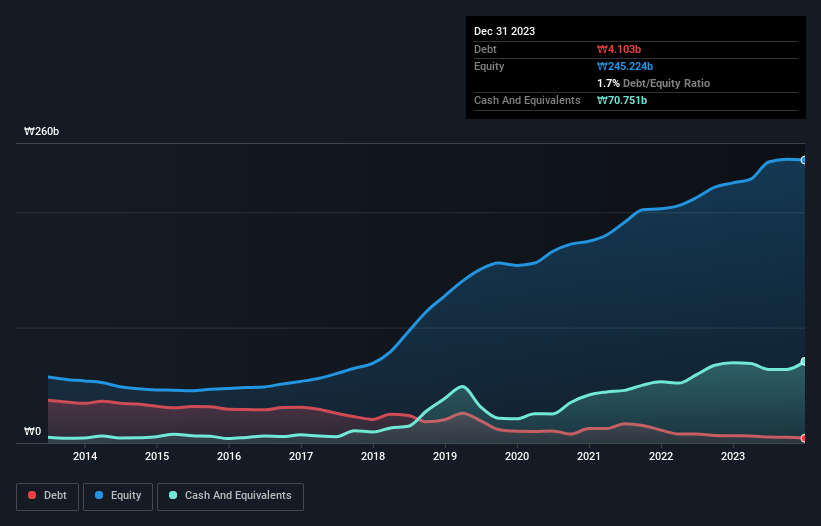- South Korea
- /
- Electronic Equipment and Components
- /
- KOSE:A001820
Does SAMWHA CAPACITORLTD (KRX:001820) Have A Healthy Balance Sheet?
Some say volatility, rather than debt, is the best way to think about risk as an investor, but Warren Buffett famously said that 'Volatility is far from synonymous with risk.' It's only natural to consider a company's balance sheet when you examine how risky it is, since debt is often involved when a business collapses. We note that SAMWHA CAPACITOR Co.,LTD (KRX:001820) does have debt on its balance sheet. But the real question is whether this debt is making the company risky.
Why Does Debt Bring Risk?
Debt is a tool to help businesses grow, but if a business is incapable of paying off its lenders, then it exists at their mercy. If things get really bad, the lenders can take control of the business. However, a more usual (but still expensive) situation is where a company must dilute shareholders at a cheap share price simply to get debt under control. Of course, the upside of debt is that it often represents cheap capital, especially when it replaces dilution in a company with the ability to reinvest at high rates of return. When we think about a company's use of debt, we first look at cash and debt together.
Check out our latest analysis for SAMWHA CAPACITORLTD
What Is SAMWHA CAPACITORLTD's Net Debt?
The image below, which you can click on for greater detail, shows that SAMWHA CAPACITORLTD had debt of ₩4.10b at the end of December 2023, a reduction from ₩6.32b over a year. However, it does have ₩70.8b in cash offsetting this, leading to net cash of ₩66.6b.

How Strong Is SAMWHA CAPACITORLTD's Balance Sheet?
We can see from the most recent balance sheet that SAMWHA CAPACITORLTD had liabilities of ₩54.7b falling due within a year, and liabilities of ₩8.13b due beyond that. Offsetting this, it had ₩70.8b in cash and ₩63.8b in receivables that were due within 12 months. So it actually has ₩71.7b more liquid assets than total liabilities.
This surplus suggests that SAMWHA CAPACITORLTD is using debt in a way that is appears to be both safe and conservative. Given it has easily adequate short term liquidity, we don't think it will have any issues with its lenders. Simply put, the fact that SAMWHA CAPACITORLTD has more cash than debt is arguably a good indication that it can manage its debt safely.
In fact SAMWHA CAPACITORLTD's saving grace is its low debt levels, because its EBIT has tanked 22% in the last twelve months. Falling earnings (if the trend continues) could eventually make even modest debt quite risky. There's no doubt that we learn most about debt from the balance sheet. But ultimately the future profitability of the business will decide if SAMWHA CAPACITORLTD can strengthen its balance sheet over time. So if you want to see what the professionals think, you might find this free report on analyst profit forecasts to be interesting.
Finally, a business needs free cash flow to pay off debt; accounting profits just don't cut it. While SAMWHA CAPACITORLTD has net cash on its balance sheet, it's still worth taking a look at its ability to convert earnings before interest and tax (EBIT) to free cash flow, to help us understand how quickly it is building (or eroding) that cash balance. During the last three years, SAMWHA CAPACITORLTD produced sturdy free cash flow equating to 61% of its EBIT, about what we'd expect. This free cash flow puts the company in a good position to pay down debt, when appropriate.
Summing Up
While we empathize with investors who find debt concerning, you should keep in mind that SAMWHA CAPACITORLTD has net cash of ₩66.6b, as well as more liquid assets than liabilities. So we are not troubled with SAMWHA CAPACITORLTD's debt use. When analysing debt levels, the balance sheet is the obvious place to start. But ultimately, every company can contain risks that exist outside of the balance sheet. Be aware that SAMWHA CAPACITORLTD is showing 2 warning signs in our investment analysis , you should know about...
At the end of the day, it's often better to focus on companies that are free from net debt. You can access our special list of such companies (all with a track record of profit growth). It's free.
New: Manage All Your Stock Portfolios in One Place
We've created the ultimate portfolio companion for stock investors, and it's free.
• Connect an unlimited number of Portfolios and see your total in one currency
• Be alerted to new Warning Signs or Risks via email or mobile
• Track the Fair Value of your stocks
Have feedback on this article? Concerned about the content? Get in touch with us directly. Alternatively, email editorial-team (at) simplywallst.com.
This article by Simply Wall St is general in nature. We provide commentary based on historical data and analyst forecasts only using an unbiased methodology and our articles are not intended to be financial advice. It does not constitute a recommendation to buy or sell any stock, and does not take account of your objectives, or your financial situation. We aim to bring you long-term focused analysis driven by fundamental data. Note that our analysis may not factor in the latest price-sensitive company announcements or qualitative material. Simply Wall St has no position in any stocks mentioned.
About KOSE:A001820
SAMWHA CAPACITORLTD
Engages in the manufacture and sale of capacitors in South Korea.
Flawless balance sheet and undervalued.
Market Insights
Community Narratives



